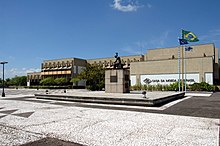Casa da Moeda do Brasil
22°53′21″S 43°44′44″W / 22.88917°S 43.74556°W
| Casa da Moeda do Brasil | |
 | |
| Agency overview | |
|---|---|
| Formed | 8 March 1694 by D. Pedro II of Portugal |
| Headquarters | Rua René Bittencourt, 371, Rio de Janeiro, Brazil |
| Agency executive |
|
| Website | www.casadamoeda.gov.br |
The Casa da Moeda do Brasil is the Brazilian mint, owned by the Brazilian government and administratively subordinated to the Ministry of Finances.[1] It was established in 1694.[2] Its current headquarters and industrial facilities occupy a modern plant with 110,000 square metres (1.2 million square feet) in Rio de Janeiro's western suburb of Santa Cruz.[3]
It produces legal tender coins and banknotes. It also produces medals and security prints (i.e., passports, subway tokens, postage stamps) that are used and issued by government-run service providers. Having the highest technology and production capacity in South America, until the 1980s it also produced coins, banknotes and passports for several South American and African countries that lacked a similar facility. It is now aiming to return to the foreign market. However, cases of corruption and deficiencies in its products have tarnished its image at the international market.[4]
See also
[edit]References
[edit]- ^ "Privatization – Brazilian National Mint". Programa de Parcerias de Ivestimentos (PPI). Archived from the original (html) on 16 October 2019. Retrieved 16 October 2019.
The Brazilian Mint - CMB is a non-dependent public corporation, incorporated under Law No. 5.895, dated June 19, 1973, linked to the Ministry of Finance, with legal personality under private law, and its capital is wholly owned To the Union. It has as its main activity, on an exclusive basis, the manufacture of paper money, metallic money and the printing of postage stamps, federal tax and federal government debt, as well as the production of Brazilian passports.
- ^ "Bolsonaro firma decreto para privatizar Casa de la Moneda de Brasil" [Bolsonaro signs decree to privatize the Brazilian Mint]. Últimas Noticias (in Spanish). 15 October 2019. Archived from the original (html) on 16 October 2019. Retrieved 16 October 2019.
Fundada en 1694, en la Casa de la Moneda se imprimen los billetes y monedas del real brasileño, así como pasaportes, sellos y diplomas; institución que, hasta el momento, respondía al Ministerio de Hacienda
- ^ Carvalho da Silva, Carlos Alberto. "Casa da Moeda do Brasil - Histórico" [Brazilian Mint - History]. Casa da Moeda do Brasil (in Portuguese). Archived from the original (html) on 6 July 2011. Retrieved 16 October 2019.
Um novo complexo industrial, que hoje representa um dos maiores do gênero no mundo, foi especificamente projetado, construído e inaugurado em 1984, no Distrito Industrial de Santa Cruz, Zona Oeste do Rio de Janeiro. Essas modernas instalações ocupam cerca de 110.000 metros quadrados de área construída, em uma área de terreno de cerca de 500.000 metros quadrados.
- ^ "ZRA awards contract to Swiss firm banned in other countries". Zambia Watchdog. 6 August 2019. Archived from the original (html) on 7 August 2019. Retrieved 16 October 2019.
Former SICPA Executive Vice President Charles Nelson Finkel was found guilty of the bribery charges. Finkel, who has American and Brazilian citizenship, paid $14.5 million in bribes to a fiscal auditor in order to secure Sicpa a contract worth more than $1 billion with the Brazilian Mint between 2010 and 2015.
External links
[edit]- Casa da Moeda do Brasil (in Portuguese)
- 1694 establishments in Brazil
- Mints (currency)
- Banknote printing companies
- Manufacturing companies based in Rio de Janeiro (city)
- Organizations established in 1694
- Executive branch of Brazil
- Government agencies established in the 1690s
- National heritage sites of Rio de Janeiro (state)
- Government-owned companies of Brazil
- Brazil government stubs
- Brazil economy stubs
